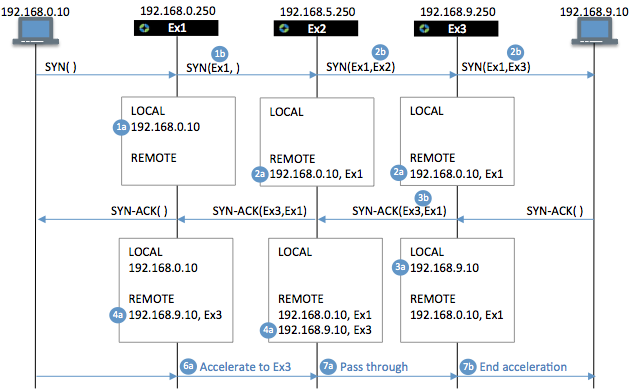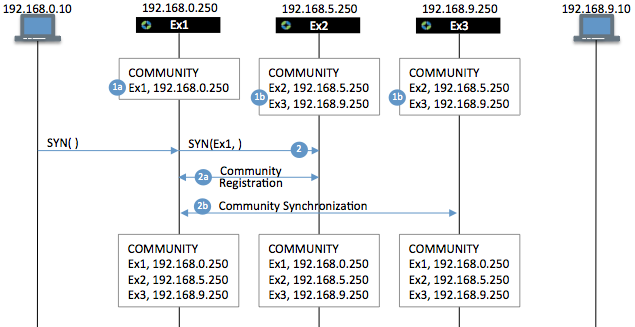
For the most part, acceleration requires two appliances - one to accelerate (such as compressing, or de-duplicating data) and one to decelerate (such as recomposing the traffic from the compressed de-duplicated traffic). Therefore each appliance must know of the other appliances with which it can accelerate. To find other appliances, the appliances have an auto-discovery process. It is used for two purposes:
Appliances that can participate in accelerated communications are discovered by detecting extra information in the flow that is required during acceleration of a flow. The appliance adds the following information to the TCP option of SYN, SYN-ACK, and the first ACK packets of each new connection:
Optionally an IP address corresponding to one of the appliances can be sent. In addition to this, each appliance must keep a list of the host IP/appliance ID pairs, which indicates which Exinda appliance terminates the acceleration for conversations with a given host IP.
The connection discovery process is as follows:

It adds the client IP to its local list.
E.g., adding 192.168.0.10 to the Ex1 local list.
It adds the auto-discovery option to the packet, filling out the source details.
E.g., adding Ex1 as the source of the SYN when leaving Ex1.
If the server exists in the appliance remote list, then the destination field is filled out with the appliance details, otherwise the destination is left blank.
It records the client IP address and source appliance ID to its remote list.
E.g., adding 192.168.0.10, Ex1 to the local lists of Ex2 and Ex3.
It fills out the destination details and forwards the packet on.
E.g., adding Ex2 as the destination of the SYN when leaving Ex2 and replacing the destination of the SYN with Ex3 when leaving Ex3.
It adds the server IP to its local list.
E.g. adding 192.168.9.10 to the local list of Ex3.
It adds an auto-discovery option with both the source and destination details filled out.
E.g., adding Ex3 as the source and Ex1 as the destination in the SYN-ACK.
It adds the server IP address and source appliance id to the remote list.
E.g. adding 192.168.9.10, Ex3 to the remote list of both Ex1 and Ex2.
A group of Exinda appliances in a network is referred to as a community. Exinda appliances that are part of the same community can accelerate to and from each other. The community is generally those Exinda appliances that were automatically discovered.
|
|
Note If an appliance is not automatically discovered, you can manually add the Exinda appliance to the community. To learn how to manually add an appliance to the community, read Configure Exinda Appliance Community. |
|---|

When an appliance receives an auto-discovery option from a source that the Exinda community does not know about, it can notify the community which will establish a connection to that appliance, and add it to the community.
This may also cause two existing communities to join together.
The Auto Discovery process is very lightweight - it adds negligible latency/delay to packets as they pass through the Exinda appliance.
|
|
|